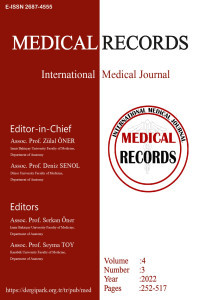The Use of Botulinum Toxin in Temporomandibular Disorders: A Bibliometric Study
The Use of Botulinum Toxin in Temporomandibular Disorders: A Bibliometric Study
Botulinum toxin, Bibliometrics, Temporomandibular disorders,
___
- Gauer RL, Semidey MJ. Diagnosis and treatment of temporomandibular disorders. Am Fam Physician. 2015;91:378-86.
- Sipahi Calis A, Colakoglu Z, Gunbay S. The use of botulinum toxin-a in the treatment of muscular temporomandibular joint disorders. J Stomatol Oral Maxillofac Surg. 2019;120:322-5. Denglehem C, Maes JM, Raoul G, Ferri J. Toxine botulinique de type a: traitement antalgique des dysfonctions de l’appareil manducateur. Rev Stomatol Chir Maxillofac. 2012;113:27-31.
- Awan KH, Patil S, Alamir AWH, et al. Botulinum toxin in the management of myofascial pain associated with temporomandibular dysfunction. J Oral Pathol Med. 2019;48:192-200.
- Jaspers GWC, Pijpe J, Jansma J. The use of botulinum toxin type a in cosmetic facial procedures. Int J Oral Maxillofac Surg. 2011;40:127-33.
- Jankovic J. Botulinum toxin in clinical practice. J Neurol Neurosurg Psychiatry. 2004;75:951-7.
- Coté TR, Mohan AK, Polder JA, et al. Botulinum toxin type a injections: adverse events reported to the us food and drug administration in therapeutic and cosmetic cases. J Am Acad Dermatol. 2005;53:407-15. Delcanho R, Val M, Nardini L, Manfredini D. Botulinum toxin for treating temporomandibular disorders: what is the evidence? J Oral Facial Pain Headache. 2022;36:6-20.
- Tarazona-Alvarez B, Lucas-Dominguez R, Paredes-Gallardo V, et al. A bibliometric analysis of scientific production in the field of lingual orthodontics. Head Face Med. 2019;15:1-10.
- Jacimovic J, Jakovljevic A, Nagendrababu V, et al. A bibliometric analysis of the dental scientific literature on covid-19. Clin Oral Investig. 2021;25:6171-83.
- Paschoal MAB, Belém FV, Clementino LC, Martins PA. Application of lasers in dentistry: a bibliometric study of the top 100 most-cited papers. Braz Oral Res. 2022;36:e104.
- Balel Y. Bibliometric analysis of international publication trends in impacted third molar surgery research (2000-2020). Br J Oral Maxillofac Surg. 2021;59:1220-6. Monroy PG, da Fonseca MA. The use of botulinum toxin-a in the treatment of severe bruxism in a patient with autism: a case report. Spec Care in Dentist. 2006;26:37-9.
- Yayın Aralığı: Yılda 3 Sayı
- Başlangıç: 2019
- Yayıncı: Zülal ÖNER
Hüseyin ERDEM, Mustafa TEKELİ, Yiğit ÇEVİK, Nazire KILIÇ ŞAFAK, Ömer KAYA, Neslihan BOYAN, Özkan OĞUZ
Ahmet YABALAK, Muhammed Nur ÖĞÜN
Sema AVCI, Sevinç ŞAHİN, Cemre Nur BALCI
Mahmut Zabit KARA, Mehmet Hamdi ÖRÜM, Ayşe Sevgi KARADAĞ, Aysun KALENDEROĞLU
The Relationship between Spondylolisthesis and Modic Changes: An MRI Study
Veysel DELEN, Alparslan YETİŞGİN, Serap SATIŞ, Safiye KAFADAR, Hamza ERDOĞDU, Saime SHERMATOVA
Investigation of the Sox-9 and Caspase-6 Immune Activity in Placentas of Pregnant Women with GDM
Ece ÖCAL, Senem ALKAN AKALIN, Engin DEVECİ
Lomber Disk Hernili Hastalarda Q açısı ve Hamstring Uzunluğunun Denge Performansına Etkisi
Tuba OZCAN METİN, Gulsen BAYRAK, Selma YAMAN, Adem DOĞANER, Atila YOLDAŞ, Nadire ESER, Duygun ALTINTAŞ AYKAN, Banu YILMAZ, Akif Hakan KURT, Mehmet ŞAHİN, Gulsah GURBUZ
